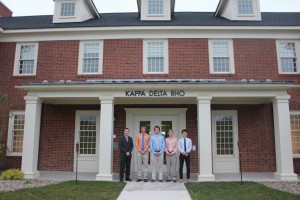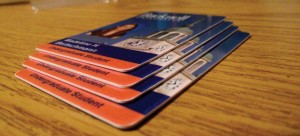Siobhan Murray
Writer
This year’s formal sorority recruitment lasted from Aug. 24 to Aug. 31 and placed 270 women into six sororities: Alpha Chi Omega fraternity, Alpha Delta Pi sorority, Chi Omega fraternity, Delta Gamma sorority, Kappa Alpha Theta fraternity and Kappa Kappa Gamma fraternity. Each organization had a quota of 42 new members. Sorority recruitment differed from last year because there were six, rather than seven, sororities engaged in the process. However, the Office of Residential Education and Fraternity and Sorority Affairs is currently reviewing applications to bring a new sorority to campus.
“Starting in the spring of 2012, seven national sororities have expressed interest and are under committee review,” said Amy Badal, associate dean of students and Director of Residential Education and Fraternity and Sorority Affairs.
Sorority recruitment consists of “Sisterhood,” “Song” and “Philanthropy” rounds, which take place over three consecutive days. During these rounds, potential new members (PNMs) are assigned a group led by a Gamma Chi, a neutral recruitment counselor. PNMs have the opportunity to go to “parties” that last for equal and specific amounts of time. As the process continues, PNMs go back to fewer and fewer sororities each day. They begin by going to all six parties, and have the opportunity to rank which sororities they would like to visit again. If they are invited back through this process of “mutual selection,” a PNM can be invited back to up to five sororities for the second round and up to four sororities for the third round. The fourth round, called “Preferentials,” took place on Aug. 28 this year. The event allows a PNM to visit up to two sororities, and after doing so, rank her possible two choices.
Aug. 31 was Bid Day, where a new member receives her formal invitation to a sorority and runs from Larison Dining Hall to the Smith Quad to meet her fellow sorority members.
“Women’s recruitment differs from men’s recruitment in that the women follow the National Panhellenic Council (NPC) guidelines, the governing body of the 26 national sororities,” Badal said. “Using Release Figure Methodology (RFM) and consulting with our RFM specialist, a NPC professional consultant, a quota is determined by taking into consideration the total number of participants in the process.”
The men’s process does not follow the same methodology, and this year it placed 226 men into fraternities. With only six sororities participating in this year’s recruitment, less PNMs may have participated, but the Office of Residential Education and Fraternity and Sorority Affairs refused to give any numbers regarding the recruitment process last year.
“I believe that fewer girls participated in recruitment this year than in past years, so from that point of view I do believe that six sororities are enough for the women participating in the process,” Gamma Chi Caitlin O’Connor ’13 said.
Some students may have chosen not to rush because they felt that they did not fit into the currently active organizations on campus.
“Not that sororities have strict stereotypes, but they do have characteristics that girls identify with. I think that perhaps girls who would have felt very comfortable at Pi Phi were left to find where they fit in during rush,” a sophomore PNM said.
Sorority women feel that the potential number of PNMs might have dropped out of recruitment due to harsher cuts that were made during the process.
“I think it was more intense [for the PNMs] this year because we had to make larger cuts and there were less spots. The quota was actually smaller this year, 42 this year verses 45 last year,” a Bucknell sorority member who took part in recruiting members this year said.



